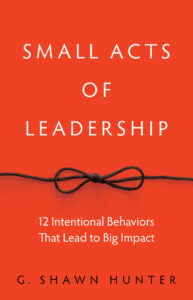What’s different about the most remarkable leaders?
How can I have a bigger impact?
How Small Acts Can Equal Big Impact
Author and serial entrepreneur G. Shawn Hunter is the founder of Mindscaling. His latest book, Small Acts of Leadership: 12 Intentional Behaviors That Lead to Big Impact, argues that it’s the simple things, when done extraordinarily well, that make a great leader.
Shawn and I talked about his book and how it’s not always the most extraordinary, sweeping actions that make the biggest impact.
I love this philosophy because all of us can make just a few adjustments and improve our leadership today.
Do One Thing At A Time
 You advocate that small, incremental choices can lead to a big impact. In your research for this book, what one small choice have you noticed in the most successful leaders?
You advocate that small, incremental choices can lead to a big impact. In your research for this book, what one small choice have you noticed in the most successful leaders?
I would say the one thing that successful people do is that they do one thing at a time. That might sound small and trifling, but, honestly, the way successful people get things done, or have meaningful conversations, is to do only that one thing. They turn off their phone when talking to people. They turn off email. They schedule time for writing and reading. They block off time for exercise and reflection. It sounds small, but it adds up.
Is it possible to teach self-confidence? What are some ways to increase it?
The biggest contributor to building self-confidence is building competence. Nothing makes you feel confident like being prepared. There is also a type of self-questioning that can be quite helpful. Instead of repeating the mantra, “Yes, I can do this!” to build self-confidence, try asking yourself if you have the capabilities to achieve what you are envisioning. If you ask specific questions of yourself, you will be forced to answer to your weaknesses and reconcile them.
Build Your Resilience
You talk about building resilience through challenge. Do challenges make the leader, or does the leader seek out challenges?
From what I understand through studying flow states, it’s a self-reinforcing paradigm, but only if you get the challenge part right. As your readers may know, flow states occur when the level of challenge presented meets (or slightly exceeds) your skill level. In that state we can become hyper-aware and hyper-focused. We also accelerate our learning. Once we feel that state, we often seek out those experiences which create flow states. There are people who can actually get addicted to inducing this type of state. They’re called Type T people, also known as adrenaline junkies.
Develop Persistent Curiosity
Persistence. I love the story of your daughter and how she ended up with a rare poster of Taylor Swift. What are some ways to develop persistent curiosity in everything we do?
Good question! The great physicist Richard Feynman once described how you can spot a real expert versus a phony. Look for three little words, “I don’t know.” The phony will have all the answers, while the experts will be willing to admit what they don’t know. Real experts are relentlessly curious, even assertively curious – that is, they will demand explanations for things that many others simply accept as rules.
Here’s an interesting fact about people who describe themselves as curious. These people are also assertive. Curious people are decision-makers. They are influencers. They often say they have direct influence over the outcome of decisions and change. If you think of the people in your company and community who consistently drive change, I bet you will be thinking of inquisitive people – people willing to ask the hard questions.
Take a Break (even if you’re busy!)
You advocate the counterintuitive advice of taking breaks when we’re busy. Why is taking a break so important? How do you get a type-A, driven leader to follow this practice?
All-nighters don’t scale. Period. In some corners of business, we have created a work environment in which it’s cool to brag about how many hours we work, and how little sleep we get, and how many deliverables we accomplish. I worked in a company once that mandated a rapid response time to every incoming message. When you create an environment which requires people to constantly monitor correspondence over email and text, the next thing they do is constantly initiate messages.
Studies demonstrate what we already know intuitively. That is, our intellectual and productivity capacity diminishes rapidly when we are sleep deprived and when we are distracted. To answer your question, organizations and leaders should reward people who deliver meaningful, thoughtful contributions, not who puts out the highest volume of email noise.
1: Believe in yourself. 2: Build confidence. 3: Introduce challenge. 4: Express gratitude. 5: Fuel curiosity. 6: Grant autonomy. 7: Strive for authenticity. 8: Be fully present. 9: Inspire others. 10. Clarify roles. 11. Defy convention. 12. Take a break.12 Intentional Behaviors for Big Impact
Defy Convention
Of the 12 critical competencies, is there one that more leaders struggle with than others?
Yes, of these 12 competencies I believe the hardest to accept is to encourage those around you to defy convention. I have an entire chapter on the importance of defying convention and deviating in a positive way. It’s the only way real innovation and progress can develop. But in order for this to happen, the leaders have to create an environment in which this is acceptable, even encouraged. I’m not talking about encouraging chaos. I’m talking about an environment in which people are encouraged to be creatively deviant.
How do these 12 competencies manifest themselves in teams?
I devote an entire section to clarifying roles because I think it’s one of the least understood dynamics of successful teams. Often we focus on hiring the strongest talent and granting them autonomy. The thinking behind this is that if we can just get the most talented people in the room, and then set them free, they will do remarkable things.
Not quite. It turns out that the most successful and productive teams also have very high role clarity – each member of the team understands the roles and responsibilities of others. This is not to say there is no role or job rotation, there is. But the specific function of each member has great clarity, which makes the entire unit achieve more, quickly.
For more information, see Small Acts of Leadership: 12 Intentional Behaviors That Lead to Big Impact.

